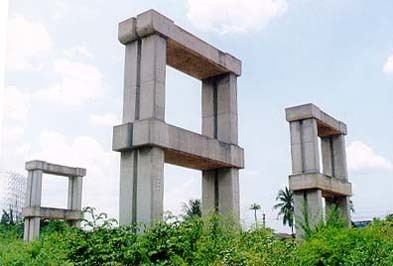 | ||
The Bangkok Elevated Road and Train System (BERTS, Thai: โครงการระบบการขนส่งทางรถไฟยกระดับในกรุงเทพมหานคร), commonly known as the Hopewell Project (โครงการโฮปเวลล์) after main contractor Hopewell Holdings, was a failed project to build an elevated highway and rail line from central Bangkok to Don Mueang International Airport. Construction started in 1990, but was suspended by the 1st government of Anand Panyarachun in 1992, and was finally halted by legal acrimony in 1997 with only 10-13% complete. The project was cancelled in 1998. Due to its resemblance to standing stones, it has been comically nicknamed "Thailand's Stonehenge".
Contents
History
The 80 billion baht (US$3.2 billion) project was approved on 9 November 1990, without a feasibility study or clear timeline for completion, as a joint project of the Thai Ministry of Transport, the State Railway of Thailand (SRT), and the Thai subsidiary of Hopewell Holdings of Hong Kong. There were to be three phases: the first a north-south line from Hua Lamphong Railway Station, Bangkok's main train station, to Don Mueang International Airport; the second an east-west line from Taling Chan District to Hua Mak; and the third a spur to the port. Totaling 60 km, all three were to be built on top of existing SRT train lines.
Rumors of corruption swirled around the project from the outset. The first part of the project was due to be in operation by December 1995, with the rest completed by December 1999. However, construction ceased in August 1997 during the Asian financial crisis, with only around 10% complete. Gordon Wu of Hopewell blamed slow land acquisition on the Thai government, while Thai officials stated that Hopewell had simply run out of money. Both sides demanded financial compensation and threatened to sue the other for breach of contract, with Hopewell claiming the work had cost it US$575 million. The project was formally terminated by the Cabinet in 1998.
Status
The project left over one thousand concrete pillars standing idle along the planned routes, described by the Bangkok Post as "a Bangkok version of Stonehenge". Revivals of the project were proposed periodically by both Hopewell and SRT, but were always shot down by the government of then Prime Minister Thaksin Shinawatra. According to an Asian Institute of Technology study, the vast majority of the pillars remain structurally sound and in usable condition, and it has been proposed to use them to build an extension of the BTS Skytrain.
Much of the Uttaraphimuk Elevated Tollway on Vibhavadi Rangsit Road parallels the BERTS north-south alignment, with some flyovers since built that obstruct parts of the route.
All of the BERTS east-west line's pillars were demolished from 2005 to 2007 during the construction of the Suvarnabhumi Airport Link, which opened to the public in August 2010. The planned SRT Red Lines would cover the rest of the BERTS north-south line, and the project has been described as a "Hopewell revival". A section of the Hopewell structure collapsed onto the main northern line on 1 March 2012. A massive concrete slab 50m by 20m collapsed near Wat Samian Nari temple in Chatuchak district. No injuries were reported.
The northern SRT Dark Red commuter Line which will run from Bang Sue to Rangsit started construction in May 2013. The 'Hopewell revival' as some term it, will be an elevated line. Shared tracks or separated tracks for High Speed Rail, DMU/Diesel Tracks, Airport Line extension and Dark Red Line Commuter will eventually be constructed.
Though some of the BERTS structures may be used for the Dark Red Line, most will be demolished. Demolition of the pillars on the north-south line started in 2013.
